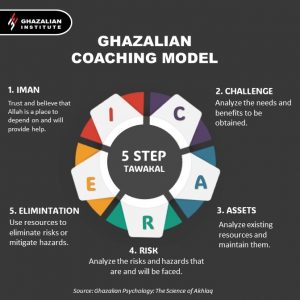Ghazalian Coaching Model.
In Al-‘Arbain fi Usul al-Din, reliance or tawwakal can be done with ‘amal such as making a strength analysis with the I-CARE approach.

1) Iman. Trust and believe that Allah is a place that depends on, and will provide help.
2) Challenge. Analyzing the needs and benefits to be obtained.
3) Assets. Analyze existing resources and maintain them; and
4) Risks. Analyze the risks and hazards that are and will be faced,
5) Elimination. Using resources to eliminate risks or mitigate hazards.
In the hadith narrated by at-Tirmidhi, it is mentioned that at the time of the Prophet Muhammad SAW there was a man who wanted to leave his camel in front of the mosque without being tied, on the grounds that he put his reliance or tawakkal on Allah SWT. When it was known to the Prophet SAW, he said, “Tie your camel first, then put your tawakkal.” Let us analyze this case using the I-CARE model. 1) Iman: entrusting to Allah; 2) Challenge: Maintaining and guarding camels; 3) Assets: Camels are valuable assets for transportation and economic activities; 4) Risks: Loss of camels affects economic activities; and 5) Elimination: Tying camels in harnesses can reduce and prevent the risk of camel loss.
Example case: Ayla is a manager who experiences workplace issues related to stress and job dissatisfaction. Ayla felt too much workload and pressure from her boss, but she also had considerable personal demands. Ayla then practiced tawakkal or reliance by analyzing the I-CARE model. 1) Iman: believes that Allah will provide help; 2) Challenge: Ayla faces the challenge of overcoming severe stress at work and increasing her job satisfaction without compromising her life balance. 3) Assets: Ayla has strong managerial experience and skills, Ayla has a competent team that can help her in her work, Ayla has good family support at home. 4) Risks: The main risk is that severe stress at work may affect physical and mental health and performance at work. Ayla may find it difficult to cope with the constant work pressure and it is possible that Ayla may be fired from the job which will make the family’s economy more difficult. 5) Elimination: Ayla uses existing resources to address her problems at work, such as starting to be more active in delegating tasks to her team. This helped to reduce her workload and gave her team the trust and opportunity to grow. Subsequently, Ayla started using more effective time management techniques, such as creating a good schedule and prioritizing important tasks. Ayla started opening better communication channels with her boss to talk about pressures and realistic expectations. She also proposed ideas for improving her team’s work efficiency. Ayla started taking better care of herself outside of work, including exercising and taking up hobbies she enjoyed, increasing time for dhikr. This helped her feel more balanced and better able to cope with stress.
With the I-CARE model, Ayla managed to reduce her workplace stress levels and increase her job satisfaction using her resources. Ayla learned to be more efficient in managing her responsibilities and maintaining a balance between her work and personal life.
